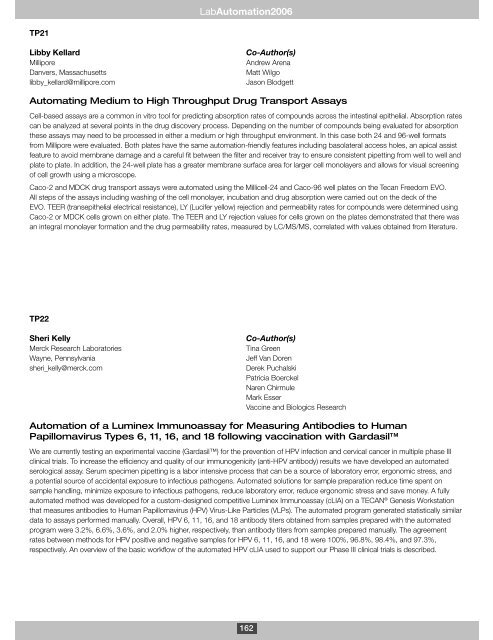LabAutomation 2006 - SLAS
LabAutomation 2006 - SLAS
LabAutomation 2006 - SLAS
You also want an ePaper? Increase the reach of your titles
YUMPU automatically turns print PDFs into web optimized ePapers that Google loves.
TP21<br />
Libby Kellard<br />
Millipore<br />
Danvers, Massachusetts<br />
libby_kellard@millipore.com<br />
<strong>LabAutomation</strong><strong>2006</strong><br />
Co-Author(s)<br />
Andrew Arena<br />
Matt Wilgo<br />
Jason Blodgett<br />
Automating Medium to High Throughput Drug Transport Assays<br />
Cell-based assays are a common in vitro tool for predicting absorption rates of compounds across the intestinal epithelial. Absorption rates<br />
can be analyzed at several points in the drug discovery process. Depending on the number of compounds being evaluated for absorption<br />
these assays may need to be processed in either a medium or high throughput environment. In this case both 24 and 96-well formats<br />
from Millipore were evaluated. Both plates have the same automation-friendly features including basolateral access holes, an apical assist<br />
feature to avoid membrane damage and a careful fit between the filter and receiver tray to ensure consistent pipetting from well to well and<br />
plate to plate. In addition, the 24-well plate has a greater membrane surface area for larger cell monolayers and allows for visual screening<br />
of cell growth using a microscope.<br />
Caco-2 and MDCK drug transport assays were automated using the Millicell-24 and Caco-96 well plates on the Tecan Freedom EVO.<br />
All steps of the assays including washing of the cell monolayer, incubation and drug absorption were carried out on the deck of the<br />
EVO. TEER (transepithelial electrical resistance), LY (Lucifer yellow) rejection and permeability rates for compounds were determined using<br />
Caco-2 or MDCK cells grown on either plate. The TEER and LY rejection values for cells grown on the plates demonstrated that there was<br />
an integral monolayer formation and the drug permeability rates, measured by LC/MS/MS, correlated with values obtained from literature.<br />
TP22<br />
Sheri Kelly<br />
Merck Research Laboratories<br />
Wayne, Pennsylvania<br />
sheri_kelly@merck.com<br />
Co-Author(s)<br />
Tina Green<br />
Jeff Van Doren<br />
Derek Puchalski<br />
Patricia Boerckel<br />
Naren Chirmule<br />
Mark Esser<br />
Vaccine and Biologics Research<br />
Automation of a Luminex Immunoassay for Measuring Antibodies to Human<br />
Papillomavirus Types 6, 11, 16, and 18 following vaccination with Gardasil<br />
We are currently testing an experimental vaccine (Gardasil) for the prevention of HPV infection and cervical cancer in multiple phase III<br />
clinical trials. To increase the efficiency and quality of our immunogenicity (anti-HPV antibody) results we have developed an automated<br />
serological assay. Serum specimen pipetting is a labor intensive process that can be a source of laboratory error, ergonomic stress, and<br />
a potential source of accidental exposure to infectious pathogens. Automated solutions for sample preparation reduce time spent on<br />
sample handling, minimize exposure to infectious pathogens, reduce laboratory error, reduce ergonomic stress and save money. A fully<br />
automated method was developed for a custom-designed competitive Luminex Immunoassay (cLIA) on a TECAN ® Genesis Workstation<br />
that measures antibodies to Human Papillomavirus (HPV) Virus-Like Particles (VLPs). The automated program generated statistically similar<br />
data to assays performed manually. Overall, HPV 6, 11, 16, and 18 antibody titers obtained from samples prepared with the automated<br />
program were 3.2%, 6.6%, 3.6%, and 2.0% higher, respectively, than antibody titers from samples prepared manually. The agreement<br />
rates between methods for HPV positive and negative samples for HPV 6, 11, 16, and 18 were 100%, 96.8%, 98.4%, and 97.3%,<br />
respectively. An overview of the basic workflow of the automated HPV cLIA used to support our Phase III clinical trials is described.<br />
162
















